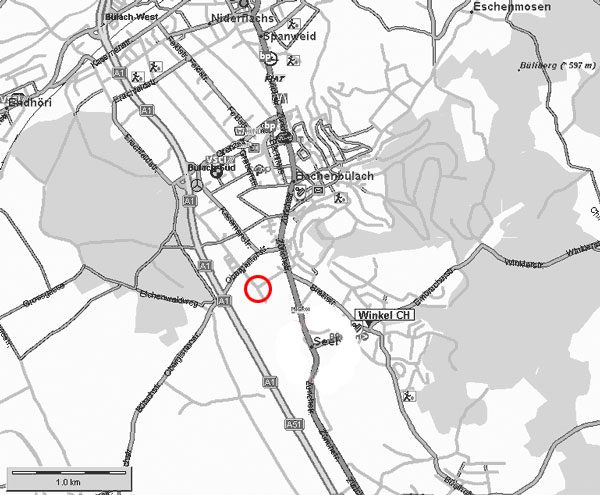There is not much left to see, but with a little imagination and fantasy it is possible to relive old times and experience the mystical atmosphere of this historical site.
Three fire pits and the surrounding area invite you to spend cozy hours or evenings around the campfire, alone or with company. At certain times you can also hear the hooting of owls and watch bats on their nightly excursions. You usually don't come across any similar creatures.
Position
Near Seeb (municipality of Winkel, canton of Zurich) on the Oberglatt-Bachenbülach road lie the remains of a Roman estate which covered approximately 8.5 hectares. As a whole, the complex, which is surrounded by a wall on three sides, corresponds to a type common in north-eastern Switzerland. The complex, as it appears today, was located on a small lake in the south in Roman times.
Story
The oldest parts of the solid masonry probably date from the 1st century. The estate was built after the founding of the legionary camp Vindonissa (Windisch) under Emperor Tiberius (14-37 AD) and was subsequently expanded further and more magnificently; Walter Drack (archaeologist) distinguishes between a wooden construction period (ca. 35-45 AD) and three stone construction periods (45-70, 70-100 and 100-250/340 AD).
In the course of the 3rd century, at the latest in 260 AD, the Alemanni, who had advanced from the north across the Rhine, destroyed a large part of the estate. It is assumed that the Seeb estate was completely abandoned at the latest after the withdrawal of the Roman troops in 401 under Emperor Honorius (395-423).
Excavations
Excavations took place in 1852-54, in the 1860s and 70s, and during both world wars. When walls were again cut into during gravel mining in 1958, the Zurich monument preservation office, under the direction of Walter Drack, began systematic archaeological investigations that lasted until 1969 and culminated in the creation of an open-air museum.
The Seeb estate was walled on three sides and divided by an inner wall into a park and a farmyard. Within the surrounding walls, an extensive manor house, a well house, a bathhouse, six other buildings, two large double courtyards, probably pens for large and small livestock, pergola-like corridors, four gates and a lime kiln were excavated.
Access
Area accessible all year round.
(Opening times of the protective structures: Easter to the end of October, Sat from 1pm to 5pm and Sun from 11am to 5pm; admission free)
By train:
From Zurich HB take S2, S16 or express train to Zurich Airport, then take postbus 530 to Winkel.
By car:
From Zurich, head towards Zurich Airport, then towards Bülach, exit Bachenbülach. At the roundabout, go straight on until you can't go any further, then turn right and then take the next entrance on the left (brown sign). Parking spaces available.















